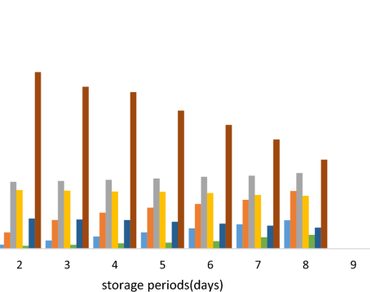Effect of storage periods and conditions on juice quality characteristics of sugarcane (Saccharum officinarum sp. Hybrid) at Finchaa sugar factory, Oromia, Ethiopia
Research Articles | Published: 25 July, 2023
First Page: 1370
Last Page: 1376
Views: 3039
Keywords: B52298 variety, NCO334 variety, Open, Physicochemical properties, Post-harvest handling, Shade
Abstract
Sugarcane storage periods and conditions are the major factors affecting sugar quality. However, the impact of storage periods and conditions on quality characteristics of sugarcane varieties grown at Finchaa sugar factory, Ethiopia, was not studied. Therefore, the study aimed to determine the impacts of cane staling periods [1, 2, 3, 4, 5, 6 and 7 days (d)] under open and shade conditions on the cane and juice quality of sugarcane varieties (B52298 and NCO334). Quality parameters were analyzed using standard analytical procedures with graded chemicals. The results showed that loss in cane weight, total soluble solids (°Brix) juice, and reduced sugar was significantly (p ≤ 0.05) increased within increasing staling periods. The results also highlighted that higher losses in cane weight, °Brix juice, and reducing sugar occurred under open and NCO334 than under shade conditions and B52298 varieties at each staling period. However, pol, purity, recoverable sugar, and sugar yield were significantly (p ≤ 0.05) increased within the decreasing staling period at 0d, followed by 1, 2, 3, 4, 5, 6, and 7 days (d) under open and shade conditions for each variety. The apparent sucrose (pol) percentage juice, purity percentage juice, recoverable sugar, and sugar yield were higher under shade than in open-air for both varieties. They were also higher in B52298 as compared to the NCO334 variety. The findings recommended that the B52298 sugarcane variety with shade conditions is highly recommended for the sugar industry to produce high sucrose content.

References
Adinew A (2001) Summary of meteorological data (1979–2002), Finchaa research station. Finchaa Sugar Estate
Ahmed AZ, El Sogheir KS (2002) Studies on post-harvest changes in sugarcane cultivars under Upper Egypt conditions. In: Proc. Mini. 1st conf. agriculture. & environmental science, 25–28, vol 22 (2-A), pp 279–289
Bamford D, Zuckerman M (2021) Encyclopedia of virology. Academic Press, New York
Bomdespacho L, Silva B, Lapa-Guimaraes J, Ditchfield C, Petrus R (2018) Cultivar affects the color change kinetics of sugarcane juice. Food Sci Technol 38:96–102
Eggleston G, Harper W (2006) Determination of sugarcane deterioration at the factory: development of a rapid, easy, and inexpensive enzymatic method to measure mannitol. Food Chem 98(2):366–372
Gamechis DU, Vighneswara RK (2020) Analysis of deterioration rate in sugarcane varieties (Saccharum officinarum sp. hybrid) under different environmental conditions at Finchaa sugarcane plantation, Finchaa, Oromia region, Ethiopia. Int J Eng Res Dev 16(8):48–53
Hussain MN, Jamali LA, Soomro SA, Chattha SH, Ibupoto KA, Abbasi NA, Qumi NM (2018) Post-harvest losses and control of unprocessed sugarcane. Pak J Agric Res 31(4):355–360
Polanco LS (2009) Assessment of target purity difference for a Louisiana sugar mill. LSU Master’s Theses. 1237. https://digitalcommons.lsu.edu/gradschool_theses/1237
Rakkiyappan P, Shekinah DE, Gopalasundaram P, Mathew MD, Asokan S (2009) Post-harvest deterioration of sugarcane with special reference to quality loss. Sugar Tech 11(2):167–170
Sarvade S, Upadhyay VB, Kumar M, Khan MI (2019) Soil and water conservation techniques for sustainable agriculture. Sustainable agriculture, forest and environmental management. Springer, Singapore, pp 133–188
Singh SB, Rao GP, Solomon S, Gopalasundaram P (2009) Sugarcane crop production and improvement. Studium Press LLC, New Delhi
Uppal SK, Sharma S, Sharma KP (1997) Post-harvest loss in cane weight and formation of mollasogenic sugars in sugarcane on staling during hot weather month. Cooper Sugar 29:172–174
Welker CA, McKain MR, Vorontsova MS, Peichoto MC, Kellogg EA (2019) Plastome phylogenomics of sugarcane and relatives confirms the segregation of the genus Tripidium (Poaceae: Andropogoneae). Taxon 68(2):246–267
Author Information
Department of Chemical Engineering, Faculty of Technology, Wollega University, Shambu, Ethiopia